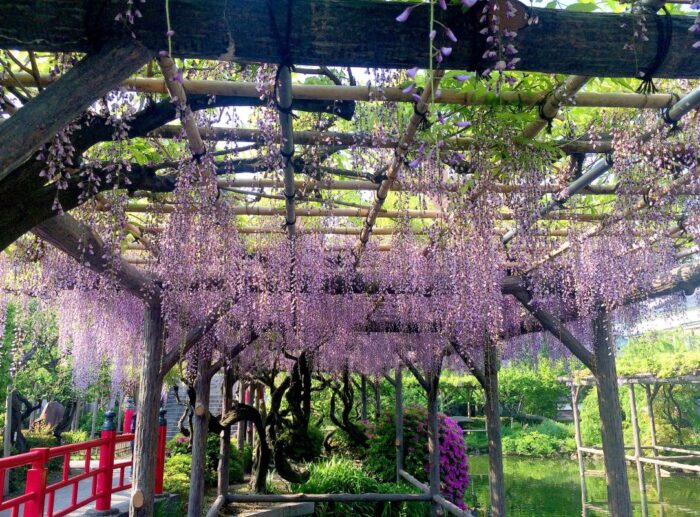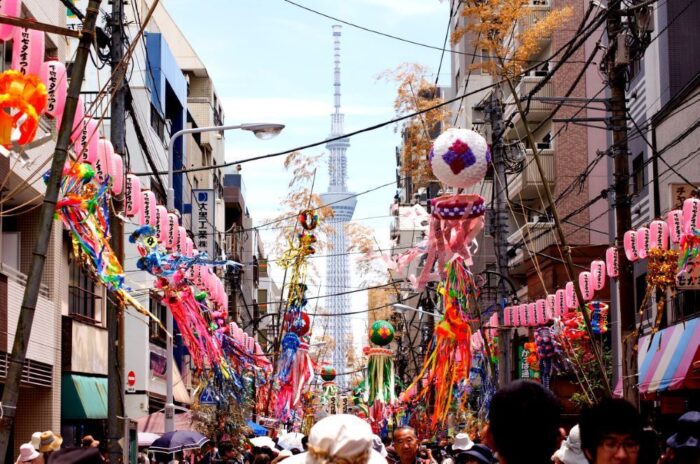The Kameido Tenjin Shrine in Tokyo is known for its annual Wisteria Festival, where over 100 blooming wisteria plants take center stage. This enchanting event combines cultural traditions with the beauty of nature, offering visitors a unique opportunity to immerse themselves in the splendor of wisteria flowers.

Dating back to the Edo period, the shrine is considered Tokyo’s prime spot for wisteria viewing. The festival provides illuminated evening views and hosts a range of events, including tea ceremonies. Visitors can enjoy this breathtaking festival for free, choosing to visit on less crowded weekdays or arriving early for a better experience.
Accessible via public transportation, the shrine also offers striking views of Tokyo’s Skytree. And if that’s not enough, visitors can even catch a glimpse of the renowned Great Wisteria Festival at Ashikaga Flower Park during their visit to Kameido Tenjin Shrine.
Key Takeaways
- Kameido Tenjin Shrine is the best spot to view wisteria in Tokyo.
- The annual Kameido Tenjin Wisteria Festival showcases over 100 blossoming wisteria plants.
- The festival offers illuminated evening views and various events like tea ceremonies.
- The shrine is located in a serene and peaceful environment, offering a break from the bustling city life.
What is it?

The Kameido Tenjin Wisteria Festival is an annual event that showcases over 100 blossoming wisteria plants, offering visitors a unique opportunity to appreciate the beauty of these flowers in full bloom. This festival celebrates the floral beauty of wisterias and holds significant historical importance.
The wisterias were planted during the Edo period and have become an integral part of the shrine’s landscape. As visitors stroll through the festival, they are surrounded by a sea of vibrant hues and intoxicating fragrances. The wisterias hold a special place in Japanese culture, symbolizing beauty and grace.
The festival not only allows visitors to enjoy the visual spectacle but also provides a deeper understanding of the historical significance of these flowers. It is a truly enchanting experience that combines nature’s beauty with a rich cultural heritage.
Cultural Significance
Surrounded by historical and artistic significance, the annual Kameido Tenjin Wisteria Festival merges cultural traditions with natural beauty. This event holds great historical significance as the wisterias were planted during the Edo period, showcasing a rich Japanese heritage.
The festival is a celebration of artistic appreciation, as over 100 blossoming wisteria plants create a stunning display of colors and fragrances. Visitors can immerse themselves in the beauty of these delicate flowers while also exploring the shrine’s historically significant views.
The festival offers a unique opportunity to witness the blending of culture and nature, as traditional tea ceremonies and illuminated evening views enhance the overall experience. It is a joyous occasion that attracts both residents and travelers, allowing them to appreciate the cultural significance of wisterias and the artistic beauty they represent.
Festival Details
Visitors can enjoy illuminated evening views and various events like tea ceremonies at the annual Kameido Tenjin Wisteria Festival. The festival offers a unique opportunity to witness the beauty of over 100 blossoming wisteria plants in full bloom.
One of the highlights of the festival is the stunning illumination effects that highlight the wisteria blooms after sundown, creating a magical atmosphere. For those looking to avoid crowds, weekday visits are recommended. Arriving early ensures a better experience and allows for a more intimate exploration of the festival grounds.
Whether you’re a nature lover or a cultural enthusiast, the Kameido Tenjin Wisteria Festival promises an unforgettable experience with its breathtaking wisteria displays and vibrant events. Don’t miss the chance to immerse yourself in the enchanting world of wisteria at this annual celebration of beauty.
Location and Transportation
Located in the heart of Tokyo, Kameido Tenjin Shrine is easily accessible via public transportation, making it convenient for visitors to attend the annual wisteria festival.
The shrine is located just over 10 minutes away from Kameido Station, and the walk provides a pleasant experience through old neighborhoods. This proximity allows festival-goers to immerse themselves in the beauty of the wisteria without the hassle of long commutes.
Whether you decide to take the JR Chūō-Sōbu Line or the Tobu Kameido Line, getting to the shrine is a breeze. The availability of public transportation also ensures that visitors have the flexibility to explore other attractions nearby, such as the Ashikaga Flower Park’s Great Wisteria Festival.
Famous Views and Attractions
The shrine’s captivating atmosphere and picturesque views of Tokyo’s Skytree make it a popular destination for both locals and travelers.
When visiting the Kameido Tenjin Shrine, visitors are not only treated to stunning vistas of the iconic Skytree, but they also have the opportunity to witness the enchanting ambiance of the Kurayami Festival.
This traditional festival, held annually at the shrine, takes place in the evening when the grounds are enveloped in darkness. The festival’s mystical lighting and performances create a sense of awe and wonder, evoking a deep emotional response from those in attendance.
Plus, a visit to the Kameido Tenjin Shrine offers the chance to catch a glimpse of the Great Wisteria Festival at Ashikaga Flower Park, further enhancing the floral escape and captivating atmosphere of the shrine.
Frequently Asked Questions
Are there any entrance fees for the Kameido Tenjin Wisteria Festival?
No, there are no entrance fees for the Kameido Tenjin Wisteria Festival. This helps with crowd management and allows visitors to freely enjoy the breathtaking sights of over 100 blooming wisteria plants.
What are some of the additional attractions or events that visitors can enjoy during the festival?
Visitors to the Kameido Tenjin Wisteria Festival can enjoy a variety of additional attractions and events. They can indulge in delicious food from the food stalls and experience cultural performances that showcase the rich traditions of Japan.
How long does the festival typically last?
The festival typically lasts for a few weeks, coinciding with the peak blooming period of the wisteria. Visitors can enjoy the vibrant colors and fragrant blooms during this time, immersing themselves in the beauty of nature.
Are there any specific tips for visiting the festival on weekends or holidays when it may be more crowded?
To avoid crowds at the Kameido Tenjin Wisteria Festival on weekends or holidays, it’s best to arrive early in the day. This way, visitors can enjoy the festival before it gets crowded and fully appreciate the beauty of the blooming wisteria.
Can visitors take public transportation to the shrine, and if so, what are the nearest stations?
Visitors can easily access Kameido Tenjin Shrine via public transportation. The nearest stations for the shrine are JR Chūō-Sōbu Line and Tobu Kameido Line. It takes just over 10 minutes to walk from Kameido Station, providing a pleasant experience through old neighborhoods.
The Sum Up
To sum it up, the Wisteria Festival at Kameido Tenjin Shrine is a must-visit event for nature lovers and cultural enthusiasts alike.
With over 100 blooming wisteria plants, visitors are treated to a mesmerizing display of beauty in full bloom.
The festival not only showcases the enchanting wisteria flowers but also offers a chance to immerse oneself in traditional Japanese customs through tea ceremonies and other events.
Located conveniently in Tokyo, this festival is easily accessible and provides stunning views of the city’s iconic Skytree.
Don’t miss the opportunity to witness the magic of wisteria in all its glory at Kameido Tenjin Shrine.





